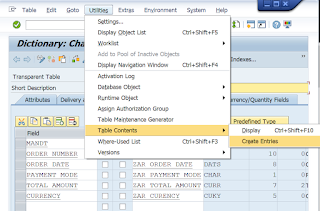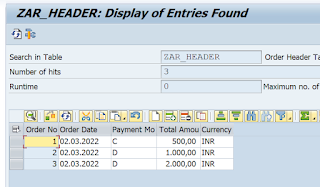Mastering SAP Table Maintenance: Insert, Update, and Delete Data with Ease
Welcome back everyone.
-
So basically, we have created our ZAR_HEADER table yesterday, So we will learn how to maintain { insert, update, delete } data in the table.
-
Open the table in change mode → go to utilities → table contents → create Entries.
-
We can see the client number automatically appears.
-
Enter the following details and click on save.
- You will get the message, database records successfully created.
-
Similarly put some more records and click on save.
-
If, I want to see the records in the button, there is a content button {Ctrl + Shift + f10}→ click on this button and press f8 {execute button }.
OR
- You can click on utilities → table contents and display
Changing data in table :-
-
Note :- We can change, only non primary key data in our table.
-
Display the entries, select the row where you want to change the data and click on change pencil button.
- Click on save and data will be changed, Again note we can only change data in non primary key.
-
Changing/Inserting/Deleting data through SE16 :-
-
Go to transaction code SE16 and enter the table and press enter → you will see the screen same as earlier.
-
We can perform the same things from SE16N also → It is basically the newer version of SE16.
-
Simply go to SE16N and click on execute → you will see a screen like below where you can do whatever you want.
-
Table Maintenance Generator :-
- We maintained our data through SE11, SE16 and SE16N,
- But In the projects, which is a live system, end users does not have the privilege to access SE11 or SE16 or SE16N
- For that purpose, we create TMG for users, this is the best way to maintain data in the table.
How to create a TMG of a table?
-
Step 1:- Go to SE11 → open your table in change mode.
-
Step 2:- Go to utilities → click on table maintenance generator.
-
Step 3:-
- Authorization group:- Suppose, a group consists of 10 people who is authorized to maintain the table.
- So, if there is any specific group provide the authorization group or else provide &NC& which simply means everyone can maintain the data
-
Step 4:- In the function group provide the table name.
-
Step 5:- Select one step in maintenance type.
- Single step :- Only overview screen is applicable.
- Two step :- Both overview screen and single screen are applicable.
-
Step 6:- Click on find Scr. Number → propose screen number → click ok
-
Step 7 :- Click on create button which is just beside the { Find Scr. Number }.
-
Step 8:- Assign the package and press enter → TMG has been created.
-
Now you can maintain your data through SM30 → simply go to SM30 and give the table and do whatever you want.
Important Points related to TMG :-
- Data browser/ table view maintenance options needs to be Display/Maintenance allowed.
- Whenever you add new columns/fields to the table after generation of TMG, the newly added fields will not appear automatically while maintaining the data with help of SM30. We need to delete the TMG and generate it again.
- Deleting the TMG never delete the table data.
- To delete the TMG, Open the table in Change Mode, otherwise delete button will not be visible.
Important Points discussed so far :-
- MANDT :- It shows the client number of SAP system.
- Table having MANDT field are called as client dependent or Client Specific tables.
- Tables does not have MANDT field are called as Client Independent tables.
- Data browser/ Table view maintenance options :-
- Display/Maintenance allowed.
- Display/Maintenance not allowed.
- Display/Maintenance allowed with restrictions.
- Size category :- A table can store how many number of records.










.png)
.png)

Comments
Post a Comment